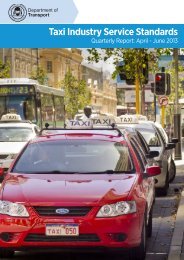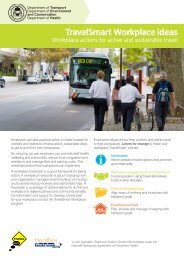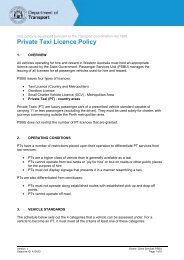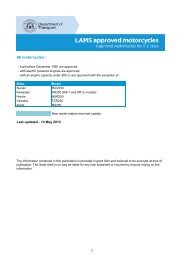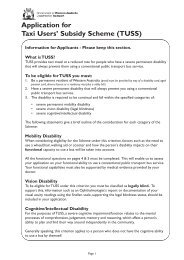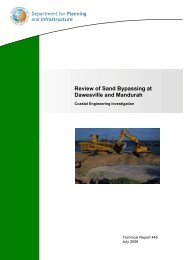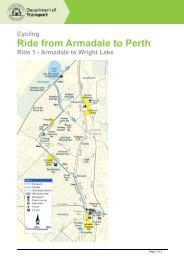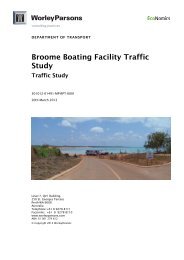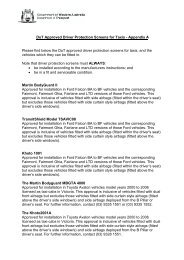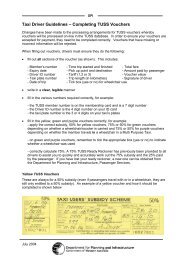Department of Transport Annual Report 2010 - 2011
Department of Transport Annual Report 2010 - 2011
Department of Transport Annual Report 2010 - 2011
Create successful ePaper yourself
Turn your PDF publications into a flip-book with our unique Google optimized e-Paper software.
Effectiveness indicator: Percentage <strong>of</strong> driver licences issued that comply<br />
with the Graduated Driver Training and Licensing System assessed by<br />
independent audit<br />
The Road Traffic Act 1974 confers on DoT responsibility for licensing the State’s<br />
drivers. Section 16 <strong>of</strong> the Road Traffic (Authorisation To Drive) Regulations 2008<br />
details the requirements prescribed under section 42 (2)(c) <strong>of</strong> the Road Traffic<br />
Act 1974. Drivers must demonstrate that they are competent to drive a vehicle<br />
through passing theoretical and practical tests, completing the prescribed hours <strong>of</strong><br />
supervised driving and passing a computerised hazard perception test.<br />
This indicator measures the extent to which licensing <strong>of</strong> drivers is conducted<br />
according to processes designed to establish levels <strong>of</strong> competence pursuant to the<br />
provisions <strong>of</strong> the Road Traffic Act 1974 and related regulations.<br />
To measure this indicator, an independent auditor conducts a sample oversight <strong>of</strong><br />
driver’s licences issued, ensuring that each key component in the Graduated Driver<br />
Training and Licensing System is completed and passed.<br />
The simple random sampling method is used to determine the applications selected.<br />
One hundred Motor Driver Licences issued are selected at random for each quarter,<br />
giving a total random sample for the year <strong>of</strong> 400 out <strong>of</strong> a total in excess <strong>of</strong> 30,000<br />
licences issued. 2 This sample size provides a confidence interval <strong>of</strong> approximately<br />
+/- 4.88 at the 95% confidence level.<br />
Percentage <strong>of</strong><br />
driver licences<br />
issued that<br />
comply with<br />
the Graduated<br />
Driver Training<br />
and Licensing<br />
System<br />
assessed by<br />
independent<br />
audit.<br />
104<br />
2007-08<br />
actual<br />
2008-09<br />
actual<br />
2009-10<br />
actual<br />
<strong>2010</strong>-11<br />
target<br />
<strong>2010</strong>-11<br />
actual<br />
85.0% 88.8% 92.0% 100% 84.5%<br />
2 Total number <strong>of</strong> driver’s licences issued relates to ‘C’ and ‘RE’ classes only.<br />
Reasons for<br />
significant<br />
variance<br />
Records<br />
management<br />
practices associated<br />
with pro<strong>of</strong> <strong>of</strong> identity<br />
documentation<br />
and log books<br />
not meeting the<br />
mandatory 25 hours<br />
<strong>of</strong> supervised driving<br />
are key contributors<br />
to the variance.<br />
Efficiency key performance indicators<br />
Service 2: Motor vehicle and driver licensing services<br />
The Road Traffic Act 1974 confers on DoT, through DVS, responsibility for licensing<br />
the State’s drivers and registering vehicles. Drivers must demonstrate they are<br />
competent to drive a vehicle through passing theoretical and practical tests,<br />
completing the prescribe hours <strong>of</strong> supervised driving and passing a computerised<br />
hazard perception test.<br />
Vehicles must be registered before they may lawfully be used on roads. Registration<br />
is conferred only where a vehicle is roadworthy.<br />
This service contributes to the Government’s outcome based service delivery <strong>of</strong><br />
‘Greater focus on achieving results in key service delivery areas for the benefit <strong>of</strong> all<br />
Western Australians’, through:<br />
setting motor vehicle standards in accordance with national and state government<br />
requirements, examining motor vehicles for compliance with those standards and<br />
registering and transferring compliant motor vehicles;<br />
setting standards and requirements within government policies for the issue <strong>of</strong> a<br />
licence to drive on roads;<br />
assessing driver competency, issuing and renewing driver licences in accordance<br />
with national and state government requirements and driver competency standards;<br />
maintaining a database <strong>of</strong> registered vehicles and drivers, and managing vehicle<br />
identification numbers to support the enforcement <strong>of</strong> road traffic and other relevant laws;<br />
collecting revenue for vehicle and driver licensing on behalf <strong>of</strong> other government<br />
agencies; and,<br />
informing and educating road users about driver licensing, vehicle registration and<br />
related requirements.



